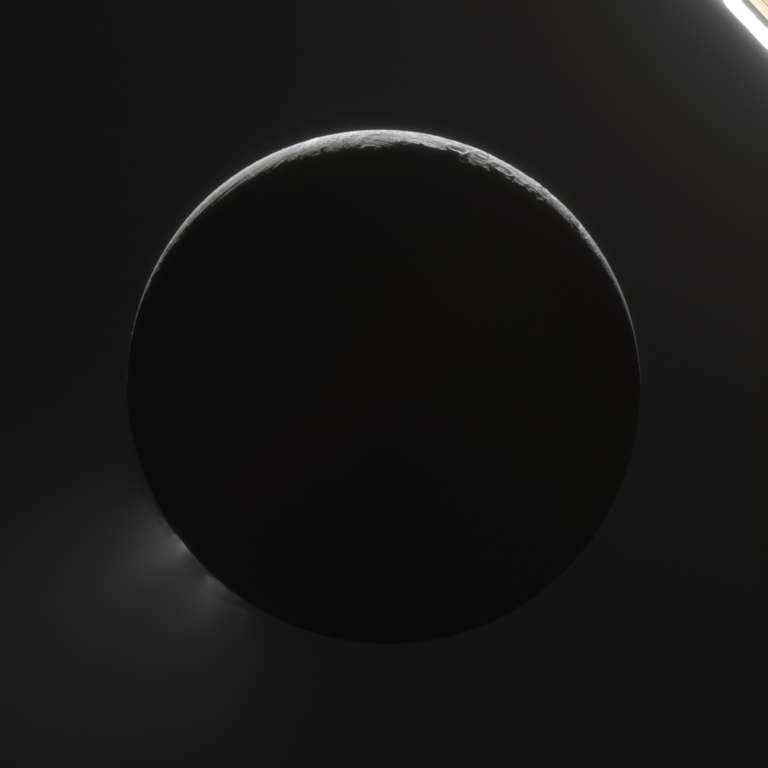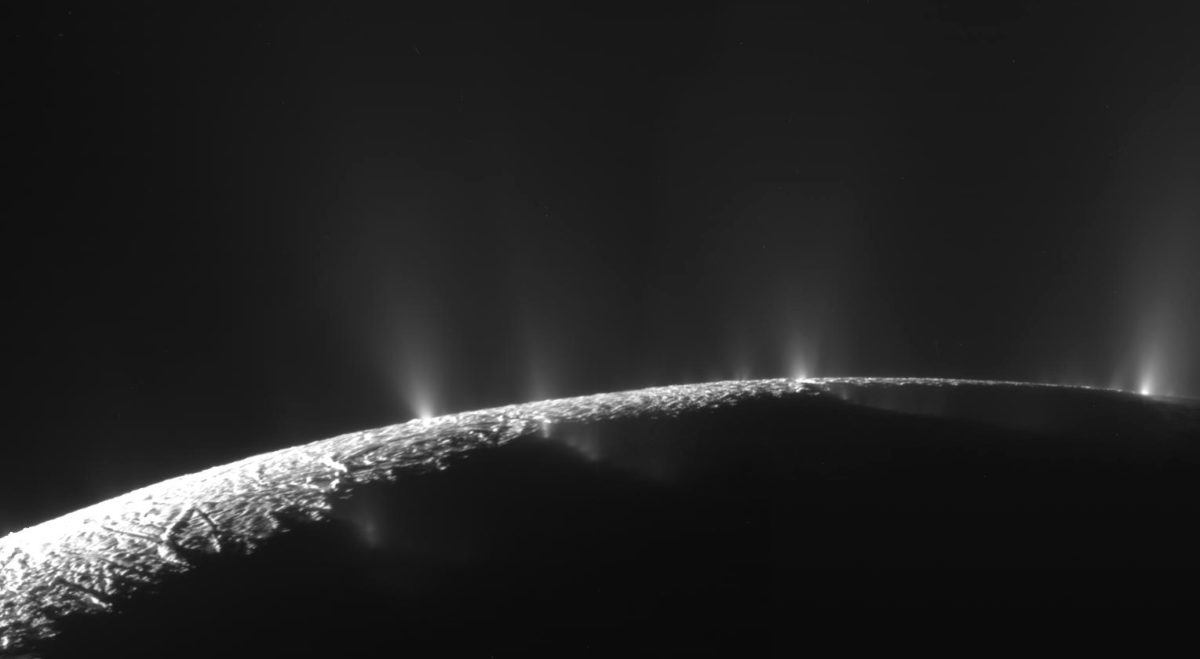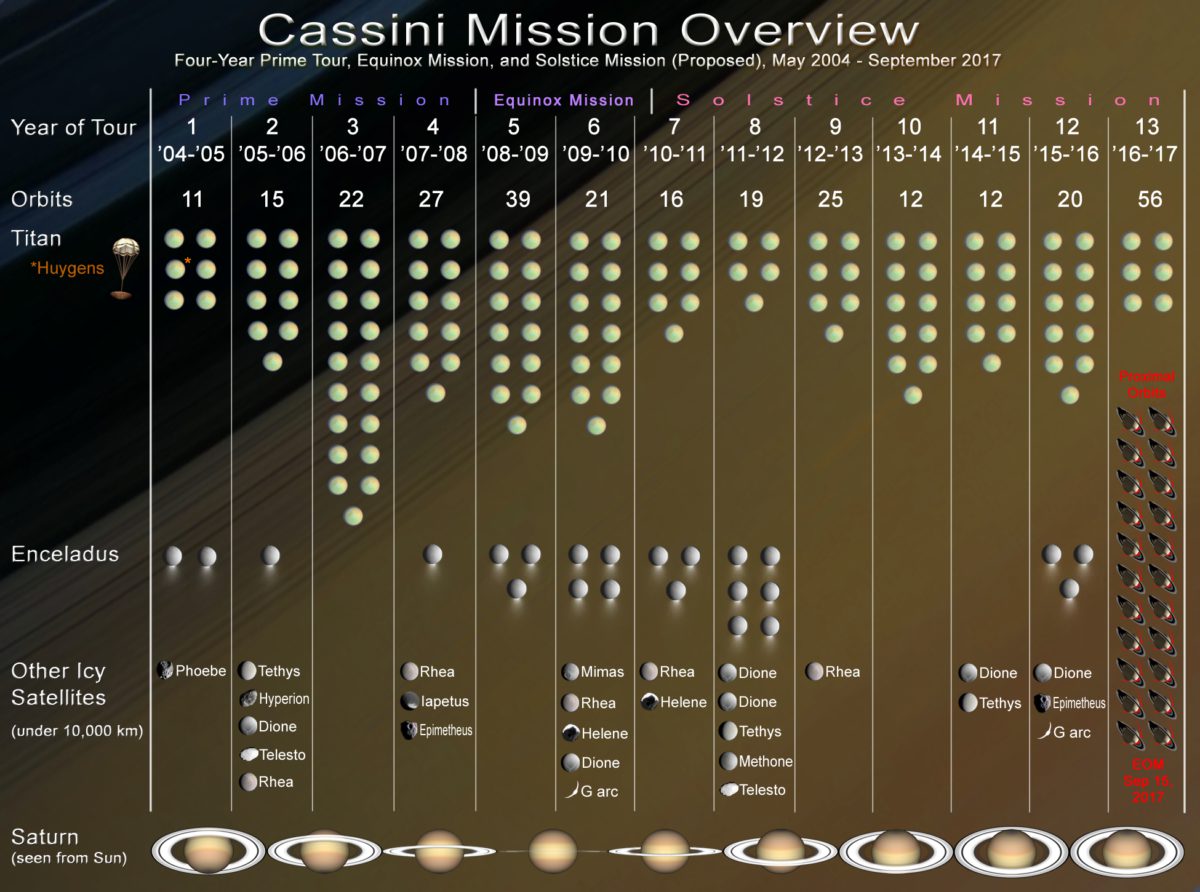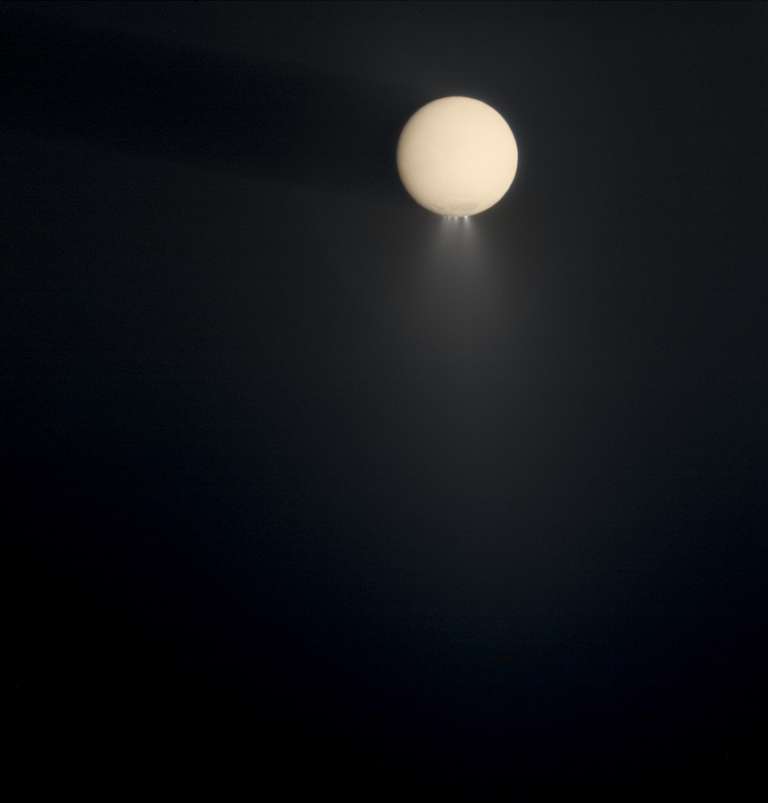Emily Lakdawalla • Dec 11, 2013
Enceladus huffs and puffs: plumes vary with orbital longitude
Here's a paper I've been meaning to write about for a long time: "An observed correlation between plume activity and tidal stresses on Enceladus." It was published in Nature last August, written by Matt Hedman and a bunch of coauthors, mostly members of the Cassini Visual and Infrared Mapping Spectrometer (VIMS) team. Its thesis: that Enceladus' plumes sometimes spout more and sometimes spout less, depending on where Enceladus is in its orbit. The variations make the plume three times brighter when it's farthest from Saturn than when it's closest to Saturn.
No matter when Cassini looks at Enceladus, its plumes always seem to be active. It's sort of amazing to think about: every minute of every hour of every day, this tiny moon of Saturn is spewing saltwater into space.

That activity results from heating of Enceladus' interior. That heating is thought to be caused by squeezing and stretching of the moon as it goes along its path around Saturn. The squeezing and stretching happens because Enceladus' orbit is not perfectly circular. Enceladus should experience more tidal deformation (being squeezed into a shape I'll call "football" for American readers and "rugby ball" for others) when it's closer to Saturn, and that stress should be relaxed when it's farther from Saturn. That squeeze and release generates heat from friction, and it should also cause the fissures at its south pole to be pressed shut and crack open slightly, once each orbit. If the fissures are sometimes more open and sometimes more shut, then there should be more plume activity when the fissures are more open, when Enceladus is farther from Saturn.
There are a lot of "shoulds" in the preceding paragraph. It's turned out to be quite difficult to go from "should" to "observed fact." Some of Cassini's other instrument teams tried to tackle this hypothesis earlier. Cassini has in-situ instruments, like the Cassini Plasma Spectrometer (CAPS), Magnetospheric Imaging Instrument (MIMI), and Ion and Neutral Mass Spectrometer (INMS), that can measure plasma and magnetic fields and scoop up particles and gases as they fly right through Enceladus' plume. In work published in the Journal of Geophysical Researc by Todd Smith and coworkers the in-situ instruments found the plume to have different density on different flybys, but of course Cassini never flew through the same part of the same plume at the same altitude at different orbital longitudes, so it was hard to turn these variable plume densities into anything systematic.
The next team to try was UVIS, the Ultraviolet Imaging Spectrograph. There was a paper in Geophysical Research Letters by Candy Hansen and coauthors, looking at three stellar occultations by the plume with UVIS. UVIS watched a bright star as it appeared to pass behind Enceladus' plume; this allows a sensitive probe of the density and composition of the plume. They reported "no evidence for substantial short-term variability." Which was really puzzling. Tectonic stresses from tides should be driving Enceladus' activity, so it'd be really odd that it didn't produce any effect on the plumes.

Enter the VIMS team. VIMS wasn't able to look for variability in Enceladus' plume for a long time because they had only one observation of the plume in all of the prime mission. Cassini's prime mission included orbits numbered 0 through 74. VIMS did one plume observation on orbit 18 and that was it. When Cassini's extended mission started, the spacecraft was in a highly inclined orbit that was great for looking at the rings, but allowed few close-up observations of Enceladus or indeed any of Saturn's moons other than Titan. It wasn't until Cassini's 119th orbit, beginning in October 2009, that Cassini returned to an equatorial orbit and VIMS and the other instruments were given the opportunity to perform lots of Enceladus imaging. That phase continued through the first part of the second mission extension, until the middle of 2012. Now Cassini is in an inclined orbit again; it will return to an equatorial orbit in March of 2015.
They started with 252 VIMS images obtained over a 7-year period. All of the images I've shown so far in this post are from a different camera, the Imaging Science Subsystem (ISS). ISS has much higher resolution than VIMS. Here's what a typical VIMS observation of Enceladus looks like; this one also contains the rings in the background. There is just the faintest of fuzz coming out of the south pole -- that's what the plume looks like to VIMS.

For each of those 252 images, Hedman figured out where Enceladus was in its orbit at each of the times it was observed. This is easier said than done. Enceladus is closest to Saturn at an orbital phase of 0 degrees, and farthest from Saturn at an orbital phase of 180 degrees. As Enceladus orbits Saturn, its longitude changes with time. That part is pretty easy to figure out. But it turns out that the periapsis of Enceladus' orbit also shifts in longitude over time. So you can't just read Enceladus' longitude with respect to Saturn and know automatically whether it's at a point relatively near to or far from Saturn -- where it is in terms of its orbital phase. I asked Matt Hedman for information on the orbital phase for each of the Enceladus flybys, because I couldn't find that information anywhere in any paper. He gave me this table of information:
| Flyby | Date and Time | long* | peri** | orbital phase |
|---|---|---|---|---|
| E0 | 2005-048T03:30:00 | 328. | 84. | 244. |
| E1 | 2005-068T09:08:00 | 245. | 91. | 154. |
| E2 | 2005-195T19:55:00 | 251. | 134. | 117. |
| E3 | 2008-072T19:08:00 | 16. | 103. | 273. |
| E4 | 2008-224T21:06:00 | 14. | 155. | 219. |
| E5 | 2008-283T19:06:00 | 13. | 174. | 199. |
| E6 | 2008-305T17:15:00 | 13. | 182. | 191 |
| E7 | 2009-306T07:42:00 | 211. | 307. | 264. |
| E8 | 2009-325T02:10:00 | 103. | 313. | 150. |
| E9 | 2010-117T08:48:00 | 24. | 7. | 178. |
| E10 | 2010-138T06:04:00 | 112. | 14. | 98. |
| E11 | 2010-225T22:29:00 | 109. | 43. | 66. |
| E12 | 2010-334T11:54:00 | 191. | 81. | 111. |
| E13 | 2010-355T01:08:00 | 191. | 87. | 104. |
| E14 | 2011-274T13:53:00 | 65. | 184. | 241. |
| E15 | 2011-292T09:22:00 | 65. | 189. | 236. |
| E16 | 2011-310T04:59:00 | 66. | 195. | 231. |
| E17 | 2012-087T18:30:00 | 82. | 243. | 199. |
| E18 | 2012-105T14:02:00 | 83. | 249. | 194. |
| E19 | 2012-123T09:31:00 | 83. | 255. | 188. |
| E20 | 2015-287T10:42:00 | 297. | 319. | 338. |
| E21 | 2015-301T15:23:00 | 67. | 324. | 104. |
| E22 | 2015-353T17:49:00 | 76. | 342. | 94. |
| * The longitude "long" is the location of Enceladus with respect to a fixed inertial direction. ** The longitude of pericenter "peri" is the location of Enceladus' orbital pericenter with respect to the same direction. | ||||
But that's not the only thing that the VIMS team had to correct for. You ideally want to make these observations when you are right behind Enceladus with respect to the Sun -- at a phase angle near 180 degrees -- but the actual phase angles were all over the place, from about 145 to 165 degrees. The higher the phase, the brighter the plume will appear. So they had to figure out how phase angle and plume brightness related to each other by examining its appearance at different phase angles at the same orbital longitude and correct their data for that. Much of the paper concerns the methods by which they made these and other corrections.
After correcting for all of the geometric effects that would cause apparent variation in brightness, they produced a plot that showed a huge, systematic trend in the brightness of the plume with respect to Enceladus' orbital longitude. It wasn't a linear trend. The plume appears to be the same brightness throughout about half its orbit around the orbital periapsis, but then at an orbital phase of 90 degrees the brightness starts increasing sharply until it peaks at apoapsis (orbital phase 180) at fully three times brighter than the plume is at periapsis.
Three times brighter! This is a huge effect! Why didn't UVIS see any evidence for variation in plume density? Did they mess up their analysis? Not at all. I chatted with Cassini project scientist Linda Spilker about that, and she told me that when the UVIS team heard about the VIMS results, the UVIS team went back and looked at their data and found that it just happened that all three times they had stellar occultations, it happened to be at similar orbital longitudes, so they had no chance to detect it. Them's the breaks!
Now that we know that Enceladus' plume output varies, the Cassini team can account for that observed variability as they plan future Enceladus observations. Cassini returns to an equatorial orbit in March of 2015; it will have three close Enceladus flybys but also many more opportunities to observe the plumes from a medium distance. So UVIS should be able to perform some stellar occultations of the plume at other orbital longitudes, to confirm the variability detected with the VIMS instrument.

If, of course, Cassini is allowed to continue. With the Administration applying pressure to NASA to defund extended missions, the Cassini mission is in very real danger of being canceled before its time, before we have a chance to follow up on what the mission has already learned about Enceladus. We won't have another spacecraft at Saturn for decades -- what a horrible waste it would be to end this mission early!

Support our core enterprises
Your support powers our mission to explore worlds, find life, and defend Earth. You make all the difference when you make a gift. Give today!
Donate

 Explore Worlds
Explore Worlds Find Life
Find Life Defend Earth
Defend Earth


